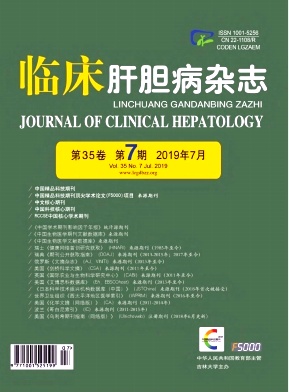|
[1] DEVER JB, SHEIKH MY. Review article:Spontaneous bacterial peritonitis—bacteriology, diagnosis, treatment, risk factors and prevention[J]. Aliment Pharmacol Ther, 2015, 41 (11) :1116-1131.
|
|
[2] ANGELONI S, LEBOFFE C, PARENTE A, et al. Efficacy of current guidelines for the treatment of spontaneous bacterial peritonitis in the clinical practice[J]. World J Gastroenterol, 2008, 14 (17) :2757-2762.
|
|
[3] FIORE M, GENTILE I, MARAOLO AE, et al. Are third-generation cephalosporins still the empirical antibiotic treatment of community-acquired spontaneous bacterial peritonitis? A systematic review and meta-analysis[J]. Eur J Gastroenterol Hepatol, 2018, 30 (3) :329-336.
|
|
[4] JINDAL A, KUMAR M, BHADORIA AS, et al. A randomized open label study of'imipenem vs. cefepime'in spontaneous bacterial peritonitis[J]. Liver Int, 2016, 36 (5) :677-687.
|
|
[5] Chinese Society of Hepatology and Chinese Society of Infectious Diseases, Chinese Medical Association. The guideline of prevention and treatment for chronic hepatitis B:A 2015 update[J]. J Chin Hepatol, 2015, 31 (12) :1941-1960. (in Chinese) 中华医学会肝病学分会, 中华医学会感染病学分会.慢性乙型肝炎防治指南 (2015年更新版) [J].临床肝胆病杂志, 2015, 31 (12) :1941-1960.
|
|
[6] European Association for the Study of the Liver. EASL clinical practice guidelines on the management of ascites, spontaneous bacterial peritonitis, and hepatorenal syndrome in cirrhosis[J]. J Hepatol, 2010, 53 (3) :397-417.
|
|
[7] PUGH RN, MURRAY-LYON IM, DAWSON JL, et al. Transection of the oesophagus for bleeding oesophageal varices[J]. Br J Surg, 1973, 60 (8) :646-649.
|
|
[8] KAMATH PS, WIESNER RH, MALINCHOC M, et al. A model to predict survival in patients with end-stage liver disease[J]. Hepatology, 2001, 33 (2) :464-470.
|
|
[9] ZHU LC, ZHU X, XU L, et al. Pathogenic bacteria in patients with liver cirrhosis and symptomatic bacterial ascites and their drug-resistance features[J]. Guangdong Med J, 2017, 38 (6) :912-915. (in Chinese) 朱龙川, 朱萱, 徐龙, 等.肝硬化并症状性细菌性腹水的病原菌及其耐药特征[J].广东医学, 2017, 38 (6) :912-915.
|
|
[10] Chinese Society of Hepatology, Chinese Medical Association.Guidelines on the management of ascites and complications in cirrhosis[J]. J Chin Hepatol, 2017, 33 (10) :1847-1863. (in Chinese) 中华医学会肝病学分会.肝硬化腹水及相关并发症的诊疗指南[J].临床肝胆病杂志, 2017, 33 (10) :1847-1863.
|
|
[11] RUNYON BA. AASLD Practice Guidelines Committee. Management of adult patients with ascites due to cirrhosis:Update 2012[EB/OL]. AASLD, 2013, https://www. aasld. org/sites/default/files/guideline_documents/141020_Guideline_Ascites_4UFb_2015. pdf.
|
|
[12] GE F, HUNAG LQ, MAO MQ. Risk factors for multidrug-resistant bacterial infection and related prevention and control measures[J]. Chin J Disinfection Sci, 2017, 34 (3) :292-294. (in Chinese) 葛芳, 黄丽晴, 毛美琴.多重耐药菌感染的危险因素与防控措施[J].中国消毒学杂志, 2017, 34 (3) :292-294.
|
|
[13] ARIZA X, CASTELLOTE J, LORA-TAMAYO J, et al. Risk factors for resistance to ceftriaxone and its impact on mortality in community, healthcare and nosocomial spontaneous bacterial peritonitis[J]. J Hepatol, 2012, 56 (4) :825-832.
|
|
[14] YANG X, SUN XF, FAN HJ, et al. Logistic regression analysis on risk factors of multi-drug resistant bacteria infection in diabetic foot disease[J]. Chin J Nosocomiol, 2017, 27 (4) :815-818. (in Chinese) 杨雪, 孙晓菲, 范慧洁, 等.糖尿病足患者多药耐药菌感染的危险因素logistic回归分析[J].中华医院感染学杂志, 2017, 27 (4) :815-818.
|
|
[15] SHALIMAR, ACHARYA SK. Difficult to treat spontaneous bacterial peritonitis[J]. Trop Gastroenterol, 2013, 34 (1) :7-13.
|
|
[16] CHAULK J, CARBONNEAU M, QAMAR H, et al. Third-generation cephalosporin-resistant spontaneous bacterial peritonitis:A single-centre experience and summary of existing studies[J]. Can J Gastroenterol Hepatol, 2014, 28 (2) :83-88.
|
|
[17] CHON YE, KIM SU, LEE CK, et al. Community-acquired vs.nosocomial spontaneous bacterial peritonitis in patients with liver cirrhosis[J]. Hepatogastroenterology, 2014, 61 (136) :2283-2290.
|
|
[18] LI DZ, ZHENG NH, LI HS. Hospital-acquired and community-acquired spontaneous bacterial peritonitis in patients with liver cirrhosis:Characteristics of pathogenic bacteria and antibiotic resistant differences[J]. Chin J Pract Int Med, 2014, 34 (12) :1210-1211. (in Chinese) 李德周, 郑南红, 李红山.肝硬化合并自发性细菌性腹膜炎医院和社区感染病原菌特征及比较研究[J].中国实用内科杂志, 2014, 34 (12) :1210-1211.
|







 DownLoad:
DownLoad: